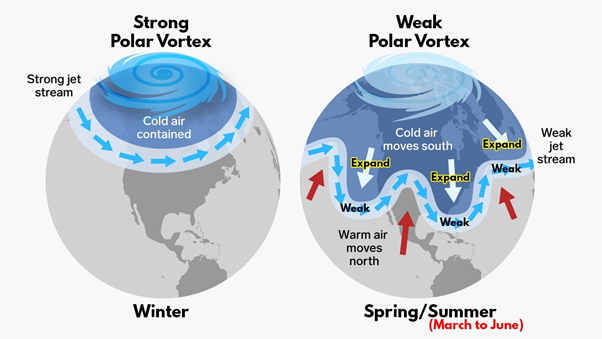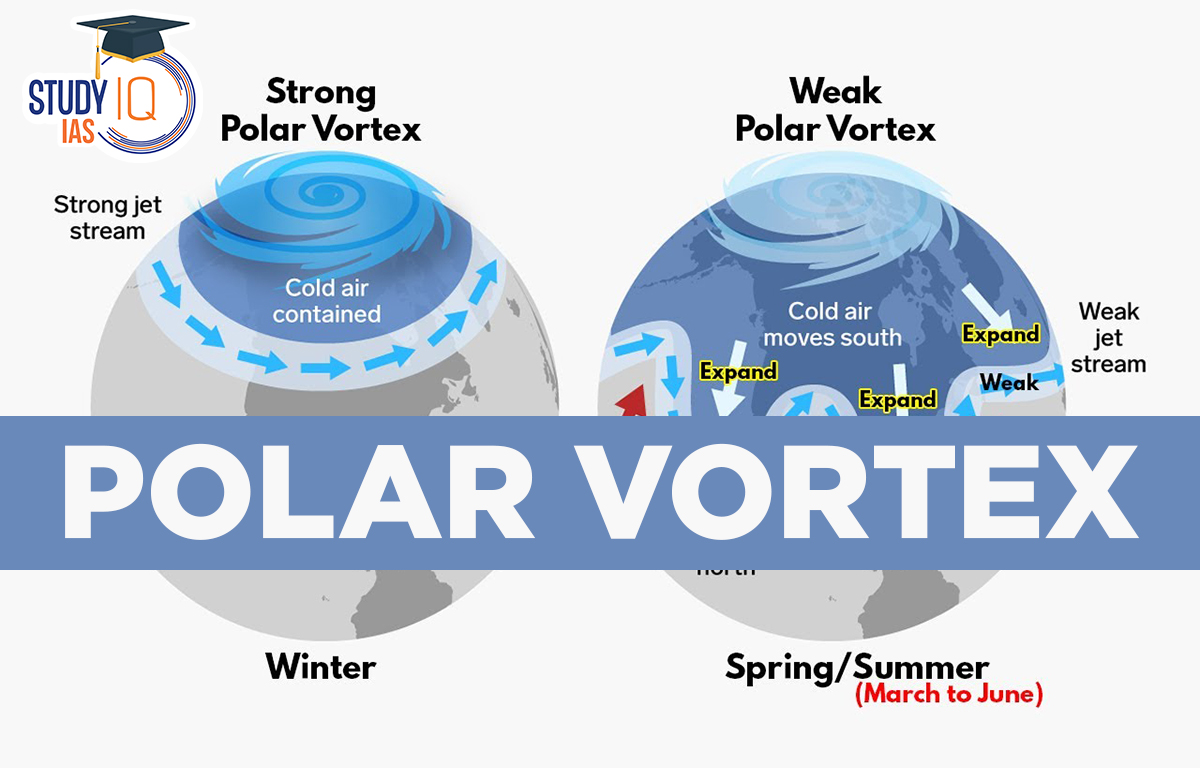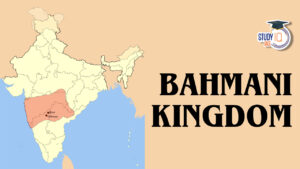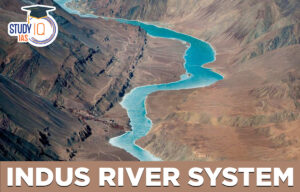Table of Contents
Context: At least 5 people have died in the United States after a winter storm hit. The extreme weather has been caused by the expansion of the polar vortex southwards.
About Polar Vortex
- A polar vortex is a large area of low-pressure, cold air that swirls around the Earth’s polar regions.
- The term vortex refers to the counter-clockwise flow of air that helps keep the colder air near the poles.
- It is of 2 types:
- Tropospheric Polar Vortex: Occurs in the lowest atmospheric layer, extending up to 10-15 km.
- Stratospheric Polar Vortex: Found at 15-50 km, strongest during autumn and disappears in summer.
How It Causes Extreme Cold
- Normally, a strong polar vortex keeps the jet stream stable in a circular path, separating cold Arctic air from warmer southern air.
- When the vortex weakens:
- The jet stream destabilizes and becomes wavy.
- Arctic air moves southward, affecting regions as far as Florida.
- High-pressure systems disrupt the vortex, pushing cold air south.
Link with Climate Change: Ongoing research explores how climate change influences the polar vortex.
- Hypothesis:
- The Arctic warms faster than other regions, weakening the vortex and jet stream.
- Weaker systems are more prone to disruptions, causing extreme cold weather further south.
Polar Vortex Diagram
The polar vortex grows and shrinks due to the movement of air and heat in the Arctic. In autumn, as the circumpolar winds speed up, the polar air rises into the stratosphere and forms a rotating air mass called the polar vortex. Here is an illustration of the polar vortex.

Polar Vortex Formation
The anticlockwise air movement that keeps the colder air close to the Poles is referred to as a “vortex.” Technically, the polar vortex refers to a band of winds that surrounds the Arctic and keeps the cold air trapped in the North. Gas dealers used to call it the “polar pig.” In winter, the polar vortex often strengthens in the Northern Hemisphere, sending cold air south with the jet stream. This can lead to severe cold spells in the U.S. during winter.
Polar Vortex Formed in Past
It has happened numerous times in the past (1977, 1982, 1985, and 1989), with the most recent instance taking place in January 2014. This is not exclusive to the United States. Cold waves also occur in parts of Europe and Asia. The polar vortex is an atmospheric feature located hundreds of feet above the ground. The main concern for people is how cold it gets as the polar vortex becomes stronger.
Polar Vortex Northern Hemisphere
Depending on its temperature, the air in the polar vortex in the Northern Hemisphere is referred to as polar air or Arctic air, with the Arctic air being the coldest. The atmosphere is substantially warmer south of the polar vortex, corresponding to sub-tropical air and, further south, tropical air. A zone of sharp temperature gradients, with temperatures falling to the north, separates the frigid air inside the vortex from the warmer air to the south.
The polar front jet stream, a relatively thin ribbon of exceptionally fast-moving air that flows mostly from west to east, is created by these high-temperature disparities. Therefore, the polar front jet stream’s location and the southern edge of the polar vortex essentially line up.
Impacts of Polar Vortex
The environment of Earth may be impacted by the following polar vortex-related events.
- When the polar vortex breaks up in the upper atmosphere, it can have strong effects on the environment, such as colder temperatures and harsh winters in the Eastern U.S., Western regions, and Northern Europe.
- Sudden warming in the stratosphere caused by the polar vortex can make the Arctic warm in both the stratosphere and troposphere. This warm air helps push cold air south, leading to colder winters in the Northern Hemisphere, especially in the Eastern U.S.
- The stratospheric warming can cause the wind pattern to change, allowing chilly air to move south. Since 1880, the average global temperature has risen by 0.8°C, while the Arctic has warmed by more than double that.
Polar Vortex and Global Warming
The polar vortex is often connected to global warming. Many issues related to global warming are believed to be caused by the polar vortex. Since the 1880s, global temperatures have increased by about 0.8°C. The Arctic has warmed and melted over twice as fast because of the polar vortex. The Arctic region’s temperature little differs from that of the North Pole, North America, or other comparable places. The Polar Vortex gets perturbed and begins to split as the energy of the Jet Streams ascends.
Polar Vortex and Jet Stream
The polar vortex and polar Jet Streams are separate entities, despite the fact that they interact with one another. The polar jet stream moves northward when the polar vortex, which is up in the stratosphere (left globe), is very strong and stable. Arctic air is captured in these containers.
Polar Vortex and Natural Cycles
The Arctic Oscillation is a pattern of changing air pressure over the Arctic and nearby areas, linked to the polar vortex. When the Arctic Oscillation is in a positive phase, the polar vortex moves closer to the pole. In a negative phase, the vortex shifts south and becomes more wavy, making the ridges and troughs more noticeable. Some researchers think changes in the Northern Hemisphere vortex are connected to warming in the Arctic caused by the loss of sea ice. However, this connection is debated and is still being studied.
| Related Articles | |
| List of Major Local Winds | Atmospheric Circulation |
| Types of Winds | El Nino and La Nina |
| Tropical Cyclone | Pressure Belts |


 Bihar Caste Census Report 2023, Caste Wi...
Bihar Caste Census Report 2023, Caste Wi...
 Bahmani Kingdom (1347-1527 AD), History,...
Bahmani Kingdom (1347-1527 AD), History,...
 Indus River System, Tributaries, and Sin...
Indus River System, Tributaries, and Sin...





















